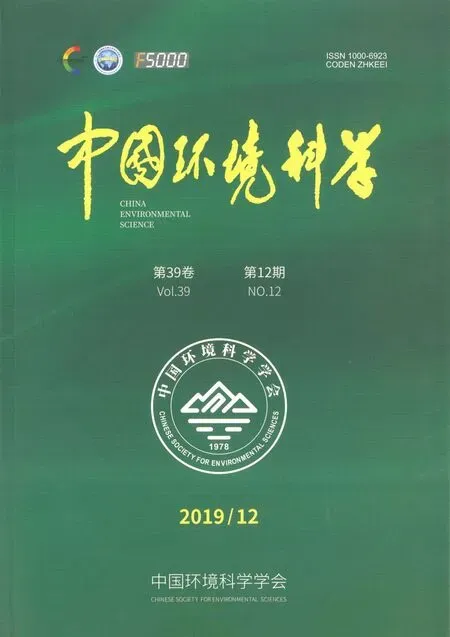典型树种挥发性有机物(VOCs)排放成分谱及排放特征
李玲玉,Alex B. Guenther,顾达萨,Roger Seco,Sanjeevi Nagalingam
典型树种挥发性有机物(VOCs)排放成分谱及排放特征
李玲玉1*,Alex B. Guenther2**,顾达萨2,3,Roger Seco2,Sanjeevi Nagalingam2
(1.青岛大学环境科学与工程学院,山东 青岛 266071;2.加州大学尔湾分校地球系统科学系,美国 加利福尼亚州尔湾 92697;3.香港科技大学环境与可持续发展学部,香港 999077)
为研究典型树种的挥发性有机物(VOCs)排放特征,并获得基础排放速率,应用动态封闭式采样系统对毛果杨、北美枫香和马尾松的排放进行了实验室测量.利用热脱附-气相色谱-飞行质谱仪对排放样品进行定性和定量分析,包括异戊二烯、单萜烯、倍半萜烯、烷烃和烯烃,计算获得各树种VOCs排放速率及其排放谱特征.研究表明:毛果杨、北美枫香和马尾松的总VOCs排放速率分别为19.51、17.19和0.67μg/(g·h).毛果杨的异戊二烯排放最高(18.51μg/(g·h)),占其总排放的94.86%;马尾松排放的异戊二烯仅占4.03%,单萜烯贡献最高,为49.09%;北美枫香的单萜烯排放速率最高,为0.84μg/(g·h);3个树种排放的倍半萜烯占各自VOCs总排放的比重均较小(<1.5%);各树种的烷烃排放强度高于倍半萜烯,部分化合物甚至高于异戊二烯和单萜烯的排放强度.反式--罗勒烯是毛果杨排放最多的单萜烯化合物,占其单萜烯总排放的99.84%;北美枫香排放的单萜烯主要以香桧烯和-蒎烯为主;马尾松以-蒎烯、香桧烯和-蒎烯为主.石竹烯、葎草烯、-杜松烯和-愈创木烯是主要的倍半萜烯物种.烷烃排放主要为C4和C5的化合物,特别是异丁烷和正丁烷;各树种排放的烯烃中,1-丁烯排放占比最高.
挥发性有机物;天然源;排放速率;排放成分谱
植物排放的挥发性有机物(VOCs)对全球环境化学和气候具有重要影响,是对流层臭氧和二次有机气溶胶的重要前体物,如异戊二烯、单萜烯、倍半萜烯、丙酮等[1–6].研究不同树种VOCs排放组成,获得基础排放速率,对准确估算区域或全球天然源VOCs排放并评估其在大气化学中的作用有重要意义.对此,国内外学者开展了大量排放测量研究,建立了基础排放速率数据库并应用于排放估算模式[7–8].然而,为获得各树种准确的排放速率需要更多的定量观测,且目前研究多集中于异戊二烯、单萜烯、倍半萜烯以及一些常见的VOCs物种.通过分析技术的改进,已有更多的未知化合物被检出[9],但其基础排放速率鲜有报道或具有较高不确定性,而这些化合物很可能导致“缺失的·OH自由基活性”[10–11].因此,需要对更多树种识别更多的VOCs物种并定量测定排放强度,准确评估排放量及其环境效应.
我国植被覆盖面积广且具有较高的生物多样性,建立本地植被物种的排放速率数据库尤为重要.对此,国内学者开展了相关的测量研究工作[12–22],已有研究仅限于异戊二烯和单萜烯,且通常采用静态封闭式采样法,测量结果存在较大误差[23].目前国内外通常采用动态封闭式采样法对植物VOCs排放进行测量,由于气体交换,封闭室内环境处于平衡状态,该方法可在最大程度避免植物的异常排放、温度、水分、CO2等的改变,测量结果更为准确.
文献报道,毛果杨()、北美枫香()和马尾松()具有高的异戊二烯或单萜烯排放强度[16,24].毛果杨和北美枫香属阔叶树种,拥有相对较多的野外和实验室测量研究[24–40],但多数研究仅限于对异戊二烯和单萜烯的测量,少量研究关注其他VOCs,如甲醇、丙酮、乙醛等羰基化合物[41–42].马尾松是我国常见的优势针叶树种并广泛分布于南方地区,覆盖面积占南方森林覆盖面积的47%[43],将对该地区天然源VOCs排放量以及大气二次污染物的生成具有较大的贡献.然而,针对该树种排放的定量测量相对较少且仅限于异戊二烯和总单萜烯排放[16,44–45].本课题组曾应用半静态封闭式采样法测量了马尾松异戊二烯、-蒎烯、-蒎烯和其他VOCs的排放速率[46],由于该方法具有较大的不确定性,未得出准确的定量结果,但证明马尾松是单萜烯高排放树种.考虑到马尾松的覆盖面积大且具有高排放强度,对其进行VOCs排放速率定量测定是十分必要的.
本研究主要目的包括:确定毛果杨、北美枫和马尾松的VOCs排放速率;研究各树种的VOCs排放组成,包括异戊二烯、单萜烯、倍半萜烯、烷烃和烯烃.
1 材料与方法
1.1 植物
盆栽毛果杨、北美枫香和马尾松购买于美国Forest Farm nursery (www.forestfarm.com),每个树种各有3个植株,树龄为1~3a,植株生长信息见表1.植株置于实验室的生长箱(2.5m×2.5m×2.5m)中,生长箱的环境条件:光合有效辐射1000μmol/(m2·s),温度23℃,相对湿度60%,模拟白天夜晚分别为12h.

表1 植株生长信息
1.2 样品的采集和分析
应用动态封闭式采样系统进行VOCs排放测量(图1),实验在美国加州大学尔湾分校生物-大气相互作用实验室进行.利用对VOCs无生成或吸附、且光合有效辐射透过率为100%的聚四氟乙烯采样袋进行封闭实验,毛果杨和马尾松使用的采样袋体积为18L,北美枫香为110L.封闭时,用采样袋罩住整个植株,并尽量减少对植株的扰动.封闭过程中,经活性炭吸附去除VOCs后的零空气以恒定流速(毛果杨和马尾松:2.5L/min;北美枫香:8L/min)持续充入采样袋内,同时袋内气体以相同流速经采样袋气体出口流出,使袋内气体处于循环状态.采样袋封闭后,平衡2~3h,用Tenax吸附柱采集袋内气体,采样流速为200mL/min,时间为30min,体积为6L.对每个树种,设3个平行样品和1个空白样品.采样结束后,测量各植株叶片干重和叶面积,其中毛果杨和北美枫香的叶面积采用网格法测量[47–48],马尾松的叶面积通过测量针叶长度和宽度计算获得,单位为cm2.
样品经热脱附-气相色谱-飞行质谱仪(Agilent GC 7890/Markes BenchTOF)进行VOCs的测定.色谱柱型号为Agilent DB-5(30m),实验设定条件:冷阱捕集温度为-10℃,热解吸温度为285℃;载气流速为1.2mL/min,分流比为1:5.2;柱箱初始温度为-30℃,最高温度为260℃,运行时间为35min.测定的化合物包括异戊二烯、单萜烯、倍半萜烯、烷烃和烯烃(不包括C3及以下的化合物).
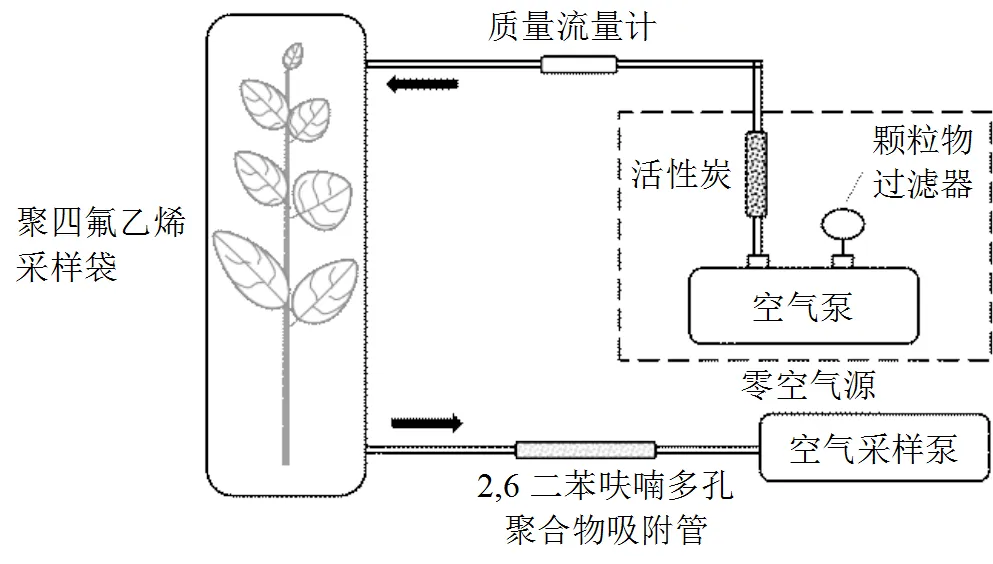
图1 动态封闭式采样系统示意
1.3 排放速率计算
排放速率计算公式为:

式中:ER为排放速率[μg/(g·h);μg/(m2·h)];为零空气流速(L/min);outlet和inlet分别为采样袋出气和进气样品的VOCs浓度(μg/m3);为叶片干重(g)或叶面积(m2).
利用Guenther算法[49],将实际环境条件下的排放测量结果标准化为标准条件(光合有效辐射为1000 μmol/(m2·s),温度为30℃)的排放速率.
2 结果与讨论
2.1 VOCs排放速率
如表2所示,毛果杨、北美枫香和马尾松的总VOCs排放速率分别为19.51,7.19,0.67μg/(g·h) (2086.91,562.35,104.03μg/(m2·h)).毛果杨作为阔叶树具有较强的异戊二烯排放,排放速率最高,为18.51μg/(g·h)(1981.41μg/(m2·h)),马尾松的异戊二烯排放速率最低,为0.027μg/(g·h)(4.1μg/(m2·h));北美枫香具有最高的单萜烯排放速率,为0.84μg/(g·h) (67.69μg/(m2·h)),而毛果杨的单萜烯排放强度最低,为0.13μg/(g·h)(14.14μg/(m2·h)).对倍半萜烯而言,毛果杨是高排放树种,排放强度远高于其他两个树种(排放速率低于0.01μg/(g·h)).毛果杨的烷烃排放速率最高,为0.53μg/(g·h)(56.18μg/(m2·h)),北美枫香最低,为0.055μg/(g·h)(3.75μg/(m2·h)).总体而言,3个树种排放烷烃的强度均高于倍半萜烯,烯烃的排放速率均低于0.05μg/(g·h).
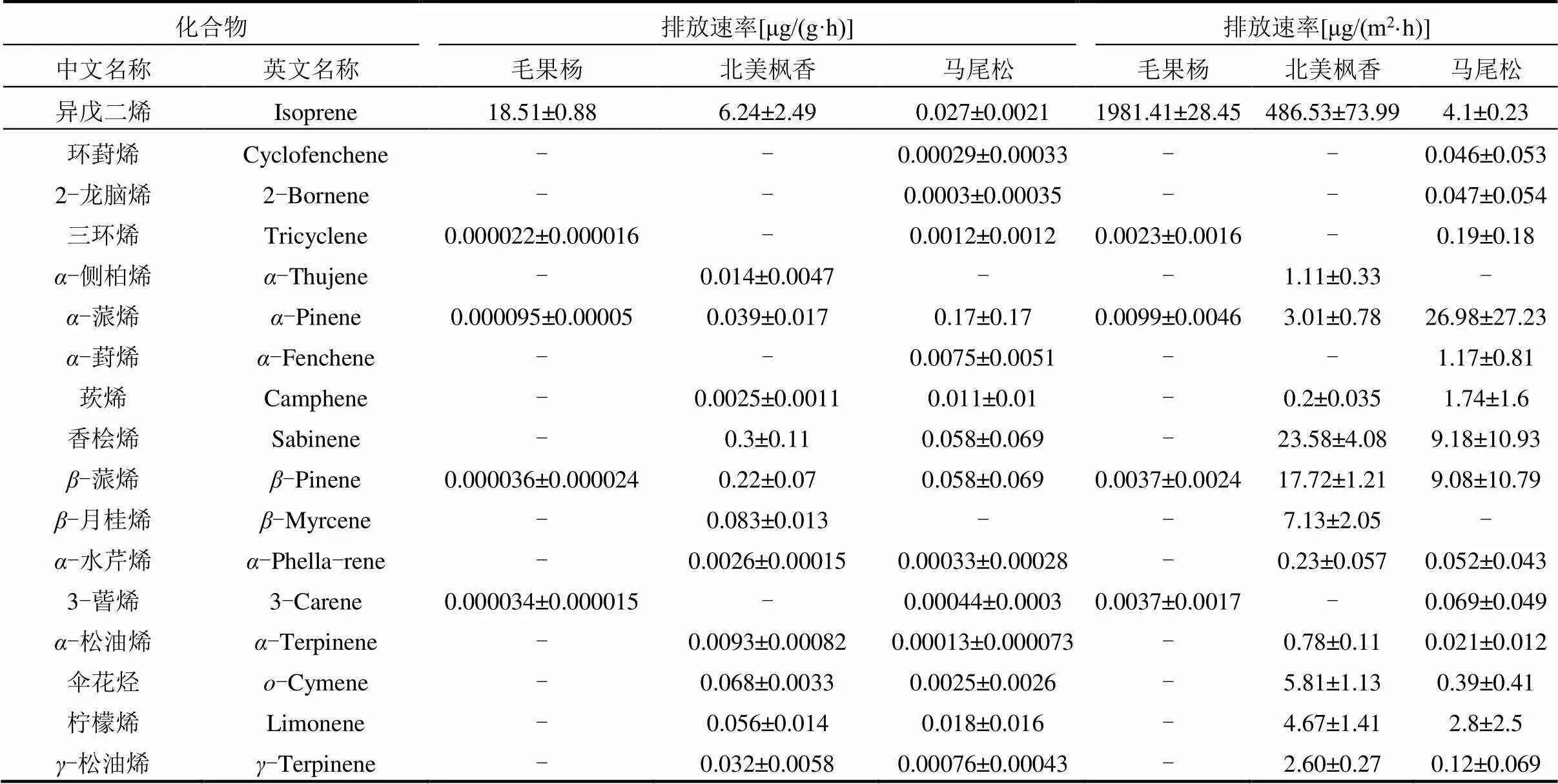
表2 毛果杨、北美枫香和马尾松的VOCs标准排放速率(均值±标准偏差)(温度:30℃,光合有效辐射:1000μmol/(m2·s))
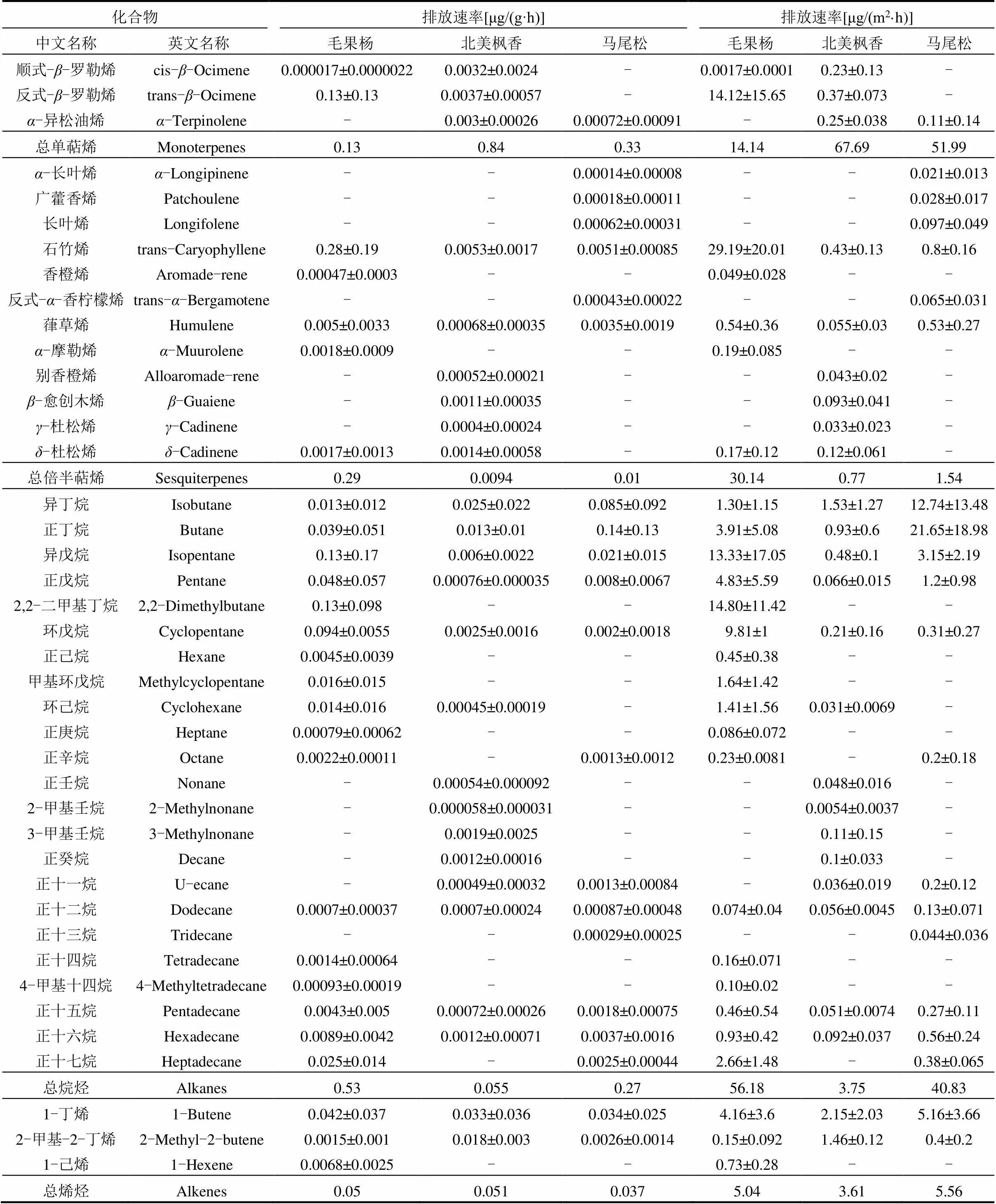
续表2
注: -为未检出,下同.
2.2 排放成分谱
如图2所示,所研究的3个树种具有不同的VOCs排放组成.总的来说,异戊二烯和单萜烯占总VOCs排放的主导地位,而倍半萜烯的贡献相对较低.毛果杨和北美枫香主要排放异戊二烯,分别占各自总VOCs排放量的94.86%和86.77%.对于针叶树马尾松而言,异戊二烯仅占总VOCs的4.03%,而单萜烯排放比例最高,为49.09%.北美枫香单萜烯的排放贡献率为11.63%,低于马尾松,但北美枫香的单萜烯排放速率却是3个树种中最高.倍半萜烯是总VOCs排放中比重相对较小的一类化合物,贡献仅不到1.5%.除具有最高的单萜烯排放比重外,马尾松释放的烷烃占总VOCs排放的百分比也较高,为39.93%,远高于其他两个树种,但其排放速率低于毛果杨.对所有研究的树种,在各自排放的VOCs中,烷烃比倍半萜烯和烯烃的贡献百分比更大.
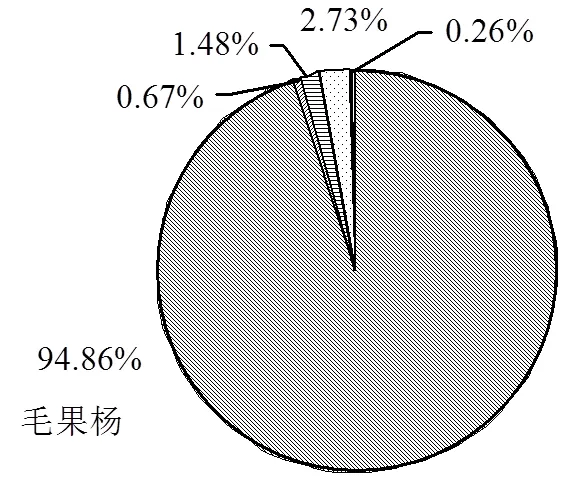

如表3所示,毛果杨检出的单萜烯化合物种类最少,以反式-β-罗勒烯为主,其占比为99.84%,排放速率为0.13μg/(g·h).其余树种检出了更多的单萜烯化合物.香桧烯和-蒎烯是北美枫香排放最多的单萜烯化合物,共占其排放总单萜烯的62.18%,其次为-月桂烯和伞花烃.-蒎烯是马尾松排放单萜烯的特征化合物,占总单萜烯排放的51.65%,其次为香桧烯和-蒎烯,贡献百分比均为17.62%.毛果杨和马尾松的VOCs排放均检出了三环烯和3-蒈烯,而在北美枫香排放的样品中未检出;-侧柏烯和-月桂烯仅在北美枫香中观测到.环葑烯,2-龙脑烯和-葑烯仅在马尾松中被检出.

表3 各树种各类化合物排放组成(%)
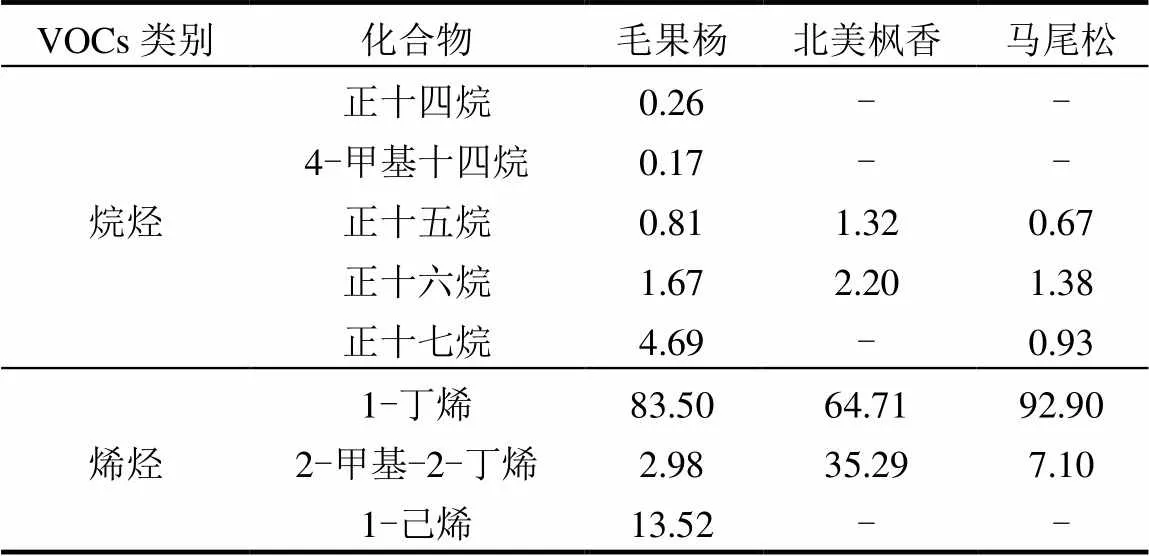
续表3
虽然石竹烯、葎草烯、δ-杜松烯和β-愈创木烯对总VOCs排放的贡献较低,但它们是3个树种排放的倍半萜烯中最主要的化合物. 3个树种的倍半萜烯化合物检出数量基本相同,但排放组成不尽相同.石竹烯是最主要的倍半萜烯化合物,分别占毛果杨、北美枫香和马尾松倍半萜烯总排放的96.90%、56.38%和51.15%.葎草烯是马尾松排放的另一种重要的倍半萜烯,在该类别中的比重为35.11%,北美枫香排放的倍半萜烯中,δ-杜松烯和β-愈创木烯是另外两个主要的组成成分.
烷烃排放主要以C4和C5化合物为主,特别是异丁烷和正丁烷.马尾松的异丁烷和正丁烷排放强度甚至高于异戊二烯;对毛果杨来说,异戊烷和2,2-二甲基丁烷能够贡献其烷烃总排放的近50%.1-丁烯是所有树种排放的烯烃中占比最高的化合物,贡献百分比为64.71%~92.90%,1-己烯仅在毛果杨排放的VOCs中被检测到.
2.3 与其他研究比较
由表4可知,以往研究中,对毛果杨和北美枫香的研究最为广泛,而对马尾松的研究却甚少.毛果杨作为阔叶树具有很强的异戊二烯释放能力,此前的研究也更多关注其异戊二烯的排放而很少有单萜烯和其他VOCs排放速率的报道.本研究中,毛果杨被确定为非常低强度的单萜烯排放树种,排放速率为0.13μg/(g·h).对于北美枫香和马尾松,仅异戊二烯和单萜烯的排放速率曾有报道,且未给出单萜烯化合物以及其他VOCs的排放组成.

表4 各研究测量结果比较
注:a背光叶片排放;b向光叶片排放;c实际环境条件且未获得;”-”表示文章中未报道.
从表4得出,对同一树种的测量结果间差异显著,本研究结果低于文献报道的排放速率,各研究结果间的差异主要是与植物的生长条件、生长阶段、难以测量的胁迫影响、测量时环境条件和测量过程中不可避免的误差等因素有关.此外,本研究选取的国内优势树种马尾松植株均产于美国,生长环境与国内不同,VOCs排放特征可能有所差异,未来将在国内对马尾松排放进行研究,比较二者的差异.
3 结论
3.1 毛果杨的总VOCs排放速率最高,为19.51μg/ (g·h)(2086.91μg/(m2·h)),马尾松最低,为0.67μg/(g·h) (104.03μg/(m2·h)).
3.2 毛果杨异戊二烯排放速率为18.51μg/(g·h),对VOCs总排放的贡献最为显著,为94.86%,使其成为一种典型的异戊二烯排放树种.针叶树种马尾松异戊二烯排放比例最低,为4.03%.
3.3 北美枫香检测到了最高的单萜烯排放速率(0.84μg/(g·h)),虽然马尾松的单萜烯排放速率并非最高(0.33μg/(g·h)),但在其排放的总VOCs中占比为最高(49.09%).
3.4 倍半萜烯对VOCs总排放的贡献相对较小,均低于1.5%.烷烃排放强度普遍高于倍半萜烯,部分化合物甚至高于异戊二烯和单萜烯.
3.5 反式--罗勒烯是毛果杨的主要单萜烯类化合物,占其总单萜烯排放的99.84%,北美枫香排放的单萜烯主要为香桧烯和-蒎烯,-蒎烯、香桧烯和-蒎烯为马尾松的主要单萜烯化合物.石竹烯、葎草烯、-杜松烯和-愈创木烯是所有树种排放的主要倍半萜烯类化合物.烷烃主要以C4和C5化合物为主,特别是异丁烷和正丁烷. 3个树种中最丰富的烯烃是1-丁烯.以上最主要的化合物能够贡献各VOCs类别的60%以上.
[1] Guenther A, Baugh B, Brasseur G,et al. Isoprene emission estimates and uncertainties for the Central African EXPRESSO study domain [J]. Journal of Geophysical Research-Atmosphere, 1999,104(D23): 30625–30639.
[2] Carslaw K S, Boucher O, Spracklen D V, et al. A review of natural aerosol interactions and feedbacks within the Earth system [J]. Atmospheric Chemistry and Physics, 2010,10(4):1701–1737.
[3] Arneth A, Schurgers G, Lathiere J, et al. Global terrestrial isoprene emission models: sensitivity to variability in climate and vegetation [J]. Atmospheric Chemistry and Physics, 2011,11(15):8037–8052.
[4] Nozière B, González N J D, Borg-Karlson A K, et al. Atmospheric chemistry in stereo: A new look at secondary organic aerosols from isoprene [J]. Geophysical Research Letters, 2011,38:L11807.
[5] Sartele, K N, Couvidat F, Seigneur C, et al. Impact of biogenic emissions on air quality over Europe and North America [J]. Atmospheric Environment, 2012,53:131–141.
[6] 赖安琪,陈晓阳,刘一鸣,等.珠江三角洲PM2.5和O3复合污染过程的数值模拟 [J]. 中国环境科学, 2017,37(11):4022–4031. Lai A Q, Chen X Y, Liu Y M, et al. Numerical simulation of a complex pollution episode with high concentrations of PM2.5and O3over the Pearl River Delta region, China [J]. China Environmental Science, 2017,37(11):4022–4031.
[7] Guenther A, Karl T, Harley P, et al. Estimates of global terrestrial isoprene emissions using MEGAN (Model of emissions of gases and aerosols from nature) [J]. Atmospheric Chemistry and Physics, 2006, 6:3181–3210.
[8] Guenther A, Jiang X, Heald C L, et al. The model of emissions of gases and aerosols from nature version 2.1 (MEGAN2.1): An extended and updated framework for modeling biogenic emissions [J]. Geoscientific Model Development, 2012,5(6):1471–1492.
[9] Karl T, Guenther A, Turnipseed A, et al. Chemical sensing of plant stress at the ecosystem scale [J]. Biogeosciences, 2008,5(5):1287–1294.
[10] Di Carlo P, Brune W H, Martinez M, et al. Missing OH reactivity in a forest: Evidence for unknown reactive biogenic VOCs [J]. Science, 2004,304(5671):722–725.
[11] Lou S, Holland F, Rohrer F, et al. Atmospheric OH reactivities in the Pearl River Delta - China in summer 2006: measurement and model results [J]. Atmospheric Chemistry and Physics, 2010,10(22):11243– 11260.
[12] 白郁华,李金龙,张宝祥,等.北京地区林木、植被排放碳氢化合物的定性监测[J]. 环境科学研究, 1994,7(2):49–54. Bai Y H, Li J L, Zhang B X, et al. The qualitative determination of hydrocarbon emitted from woods and vegetations over Beijing area [J]. Research of Environmental Sciences, 1994,7(2):49–54.
[13] 白建辉,林凤友,万晓伟,等.长白山温带森林挥发性有机物的排放通量[J]. 环境科学学报, 2012,32(3):545–554. Bai J, Lin F, Wan X,et al. Volatile organic compound emission fluxes from a temperate forest in Changbai Mountain [J]. Acta Scientiae Circumstantiae, 2012,32(3):545–554.
[14] Bai J, Guenther A, Turnipseed A, et al. Seasonal and interannual variations in whole-ecosystem isoprene and monoterpene emissions from a temperate mixed forest in Northern China [J]. Atmospheric Pollution Research, 2015,6(4):696–707.
[15] 赵美萍,邵 敏,白郁华,等.我国几种典型树种非甲烷烷烃类的排放特征[J]. 环境化学, 1996,15(1):69–75. Zhao M P, Shao M, Bai Y H, et al. Study on NMHC emission characteristics of several typical trees in China. Environmental Chemistry, 1996,15(1):69–75.
[16] Klinger L F, Li Q J, Guenther A B,et al. Assessment of volatile organic compound emissions from ecosystems of China [J]. Journal of Geophysical Research-Atmospheres, 2002,107(D21):4603.
[17] 赵 静,白郁华,王志辉,等.我国植物VOCs 排放速率的研究[J]. 中国环境科学, 2004,24(6):654–657.Zhao J, BaiY H, Wang Z H, et al. Studies on the emission rates of plants VOCs in China [J]. China Environmental Science, 2004,24(6):654–657.
[18] Tsui K Y, Guenther A, Yip W K,et al. A biogenic volatile organic compound emission inventory for Hong Kong [J]. Atmospheric Environment, 2009,43(40):6442–6448.
[19] Chang J, Ren Y, Shi Y, et al. An inventory of biogenic volatile organic compounds for a subtropical urban-rural complex [J]. Atmospheric Environment, 2012,56:115–123.
[20] 郭 霞.云南省典型乔木植物挥发性有机物释放规律研究[D]. 昆明:昆明理工大学, 2012. Guo X. The research on release regularities of biogenic volatile organic compounds from the typical plants in Yunnan [D]. Kunming: Kunming University of Science and Technology, China, 2012.
[21] 包 海,李 亮,乌 云,等.呼和浩特市几种绿化树种挥发性有机物排放量的测定 [A]//中国环境科学学会学术年会论文集(2014) [C]. 北京:中国环境科学学会, 2014:6542–6545.Bao H, Li L, Wu Y, et al. Measurements of volatile organic compounds emissions of several tree species in Hohhot [A]//Proceedings of 2014 Annual Meeting of Chinese Society for Environmental Sciences [C]. Beijing:Chinese Society for Environmental Sciences, 2014:6542–6545.
[22] 杜昌笛,包 海,赵圆圆.内蒙古沙漠化草原生物源挥发性有机物排放特征 [J]. 中国环境科学, 2019,39(5):1854–1861. Du C D, Bao H, Zhao Y Y. The emission of biogenic volatile organic compounds from desert grassland in Inner Mongolia [J]. China Environmental Science, 2019,39(5):1854–1861.
[23] Niinemets Ü, Kuhn U, Harley P C, et al. Estimations of isoprenoid emission capacity from enclosure studies: measurements, data processing, quality and standardized measurement protocols [J]. Biogeosciences, 2011,8(8):2209–2246.
[24] Guenther A, Zimmerman P R, Wildermuth M. Natural volatile organic compound emission rate estimates for U.S. woodland landscapes [J]. Atmospheric Environment, 1994,28(6):1197–1210.
[25] Guenther A, Greenberg J P, Harley P,et al. Leaf, branch, stand and landscape scale measurements of volatile organic compound fluxes from US woodlands [J]. Tree Physiology, 1996,16(1/2):17–24.
[26] Guenther A, Zimmerman P R, Klinger L, et al. Estimates of regional natural volatile organic compound fluxes from enclosure and ambient measurements [J]. Journal of Geophysical Research, 1996,101(D1):1345–1359.
[27] Fang C, Monson R K, Cowling E B. Isoprene emission, photosynthesis, and growth in sweetgum () seedlings exposed to short- and long-term drying cycles [J]. Tree Physiology, 1996,16(4):441–446.
[28] Wiberley A E, Donohue A R, Westphal M M, et al. Regulation of isoprene emission from poplar leaves throughout a day [J]. Plant, Cell and Environment, 2009,32(7):939–947.
[29] Irmisch S, Jiang Y, Chen F, et al. Terpene synthases and their contribution to herbivore–induced volatile emission in western balsam poplar () [J]. BMC Plant Biology, 2014,14:270.
[30] Dani K G, Jamie I M, Prentice I C, et al. Evolution of isoprene emission capacity in plants [J]. Trends in Plant Science, 2014,19(7): 439–446.
[31] Wiberley A E, Donohue A R, MeierM E, et al. Regulation of isoprene emission inleaves subjected to changing growth temperature [J]. Plant, Cell and Environment, 2008,31(2):258–267.
[32] Guidolotti G, Calfapietra C, Loreto F. The relationship between isoprene emission, CO₂ assimilation and water use efficiency across a range of poplar genotypes [J]. Physiologia Plantarum, 2011,142(3):297–304.
[33] Geron C, Harley P, Guenther A. Isoprene emission capacity for US tree species [J]. Atmospheric Environment, 2001,35(19):3341–3352.
[34] Harley P, Guenther A, Zimmerman P. Effects of light, temperature and canopy position on net photosynthesis and isoprene emission from sweetgum () leaves [J]. Tree Physiology, 1996, 16(1/2):25–32.
[35] Wilkinson M J, Monson R K, Trahan N,et al. Leaf isoprene emission rate as a function of atmospheric CO2concentration [J]. Global Change Biology, 2009,15(5):1189–1200.
[36] Karlik J F, Winer A M. Measured isoprene emission rates of plants in California landscapes: comparison to estimates from taxonomic relationships [J]. Atmospheric Environment, 2001,35(6):1123–1131.
[37] Lahr E C, Schade G W, Crossett C C, et al. Photosynthesis and isoprene emission from trees along an urban-rural gradient in Texas [J]. Global Change Biology, 2015,21(11):4221–4236.
[38] Corchnoy S B, Arey J, Atkinson R. Hydrocarbon emissions from twelve urban shade trees of the Los Angeles, California, Air Basin [J]. Atmospheric Environment. Part B. Urban Atmosphere, 1992,26(3):339–348.
[39] Evans R C, Tingey D T, Gumpertz M L, et al. Estimates of isoprene and monoterpene emission rates in plants [J]. Botanical Gazette, 1982,143(3):304–310.
[40] Zimmerman P R. Determination of emission rates of hydrocarbons from indigenous species of vegetation in the Tampa/St. Petersburg, Florida Area [R]. EPA Contract No. 904/9-77-0282, prepared by the Tampa Bay Area Photochemical Oxidant Study, 1979.
[41] Nemecekmarshall M, Macdonald R C, Franzen J J, et al. Methanol emission from leaves - Enzymatic detection of gas-phase methanol and relation of methanol fluxes to stomatal conductance and leaf development [J]. Plant Physiology, 1995,108(4):1359–1368.
[42] Karl T, Harley P, Guenther A, et al. The bi-directional exchange of oxygenated VOCs between a loblolly pine () plantation and the atmosphere [J]. Atmospheric Chemistry and Physics, 2005,5:3015–3031.
[43] 张新时.中华人民共和国植被图(1:100万) [M]. 北京:地质出版社, 2007. Zhang X S. The vegetation map of the People's Republic of China (1:1000000) [M]. Beijing: Geological Publishing House, 2007.
[44] Su J W, Zeng J P, Qin X W, et al. Effect of needle damage on the release rate of Masson pine () volatiles [J]. Journal of Plant Research, 2009,122(2):193–200.
[45] Quan W, Ding G. Root tip structure and volatile organic compound responses to drought stress in Masson pine (Lamb.) [J]. Acta Physiologiae Plantarum, 2017,39(12):258.
[46] Li L, Li Y, Xie S. A statistical approach for estimating representative emission rates of biogenic volatile organic compounds and their determination for 192plant species/genera in China [J]. Atmospheric Chemistry and Physics Discussion, 2017.
[47] 盛 双,王国聪,颜 权,等.大叶桉叶面积测定方法的比较研究 [J]. 广西林业科学, 2011,40(2):140–142. Sheng S, Wang G C, Yan Q, et al. A comparison study on the method of measuring leaf area of[J]. Guangxi Forestry Science, 2011,40(2):140–142.
[48] 梁雪梅,高敏华.基于GIS的植物叶片信息测量研究 [J]. 湖北农业科学, 2017,56(11):2139–2144.Liang X M, Gao M H. Study on information measurement of plant leaf based on GIS [J]. Hubei Agricultural Sciences, 2017,56(11):2139–2144.
[49] Guenther A, Zimmerman P R, Harley P C, et al. Isoprene and monoterpene emission rate variability - model evaluations and sensitivity analyses [J]. Journal of Geophysical Research-Atmosphere, 1993,98(D7):12609–12617.
Biogenic emission profile of volatile organic compounds from poplar, sweetgum, and pine trees.
LI Ling-yu1*, Alex B. Guenther2**, GU Da-sa2,3, Roger Seco2, Sanjeevi Nagalingam2
(1.College of Environmental Sciences and Engineering, Qingdao University, Qingdao 266071, China;2.Department of Earth System Science, University of California, Irvine, California 92697, USA;3.Division of Environment and Sustainability, Hong Kong University of Science and Technology, Hong Kong 999077, China)., 2019,39(12):4966~4973
In order to study the characteristics of biogenic volatile organic compounds (BVOCs) emission from typical trees and obtain their basic emission rates for each BVOC compound, a dynamic enclosed system was used to conduct laboratory measurements on poplar, sweetgum, and pine trees. BVOC compounds including isoprene, monoterpenes, sesquiterpenes, alkanes, and alkenes were analyzed by TD-GC-TOFMS. The normalized species-specific BVOC emission rates of three tree species were calculated and their emission profiles were investigated. The total BVOC emission rates of,, andwere 19.51, 7.19, and 0.67μg/(g·h) (2086.91, 562.35, and 104.03μg/(m2·h)), respectively.had the highest isoprene emission rate of 18.51μg/(g·h), contributing 94.86% to the total BVOC emissions.had a lower isoprene contribution (4.03%), but the highest monoterpenes contribution (49.09%.had the highest monoterpenes emission rate of 0.84μg/(g·h). Sesquiterpenes contributed less than 1.5% to the total BVOC emissions for the three plants. The emission rates of alkanes for each tree species were generally higher than those of sesquiterpenes, and some were even higher than those of isoprene and monoterpenes. Trans--ocimene was the predominated monoterpene for, accounting for 99.84% of its total monoterpene emissions. The monoterpenes emitted by.was mainly composed by Sabinene and-pinene.-Pinene, sabinene, and-pinene were observed as the dominated monoterpenes for. Trans-caryophyllene, humulene,-cadinene, and-guaiene were prominent sesquiterpenes. Alkanes emitted from the three plants were mainly C4 and C5 compounds, of which particularly were isobutane and butane. 1-Butene was the most abundant alkene for all plants.
VOCs;biogenic;emission rate;emission profile
X511
A
1000-6923(2019)12-4966-08
李玲玉(1987-),女,山东潍坊人,博士研究生,副教授,主要从事植物挥发性有机物排放、大气化学与污染控制等方面的研究.发表论文15篇.
2019-05-15
国家自然科学基金资助项目(41705098);山东省高等学校科技计划资助项目(J17KA105);美国国家自然基金资助项目(AGS-1643042)
* 责任作者, 副教授, lilingyu@qdu.edu.cn; **, 教授, alex.guenther@uci.edu
——结构和生物活性

